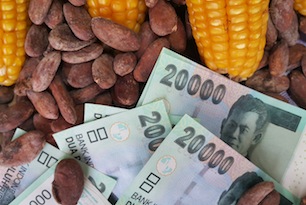Agro-Finance: The Role of Informal Lending
Rick van der Kamp
IFC Senior Operations Officer
 In the previous issue, we looked at farmers’ “access to finance” and some of the assumptions often made – we saw that farmers don’t necessarily lack access to finance on the whole, but that they don’t use bank loans a lot. For this issue, I wanted to look at the role of informal lending. Assumptions are often made about transactions in the informal market, and come down to something like:
In the previous issue, we looked at farmers’ “access to finance” and some of the assumptions often made – we saw that farmers don’t necessarily lack access to finance on the whole, but that they don’t use bank loans a lot. For this issue, I wanted to look at the role of informal lending. Assumptions are often made about transactions in the informal market, and come down to something like:
“Sure, farmers can get a loan if they are desperate, but this puts them at the hands of greedy moneylenders and into a debt-cycle they can never get out of..!”
The non-transparent nature of informal lending – interest rates may not be stated, penalties are not clear, repayment may be in-kind, and so on – can lead to the conclusion that informal lenders are usurious, and they prey on the weak and desperate to maintain a cycle of dependence. This leads people to conclude that farmers will instantly switch to more formal types of lending when available, or even that policy objectives should focus on eliminating the informal finance sector.
Farmer surveys — at least in Indonesia — usually list multiple sources of informal farmer credit; family, friends, village heads, full-time money lenders, crop collectors, and agro-input shops are all mentioned. In most situations where there is no monopoly, any one lender who consistently abuses his or her power will be in business for, well…, one or two loan cycles at most. This does not discount the many examples of where moneylenders have taken advantage of their position, but it does mean that the informal lending sector as a whole (I would not dare to make a size estimate, but definitely larger than the entire formal agri-finance sector) needs a certain balance between risk and reward to function.
Unfortunately, information about informal lending interest rates is difficult to obtain; rates are not always explicit and can vary a lot by source. The scarce evidence available does point to higher rates; farmers in West Bengal, India, for example saw moneylender rates averaging at 26% in 2014, substantially above commercial and group lending rates. Other sources confirm that informal lending generally is more flexible, but comes at a premium over formal credit.
It appears that where more flexibility is required (no collateral, fast money, more personal contact, individual loan terms, possibility to roll over, and so on), the cost of lending goes up. Perhaps informal lending is somewhat like credit card debt for the modern, urban consumer – we all know card companies charge very high interest rates, but appreciate the flexibility, and do lean on it occasionally when we’re in need, without (always) blaming the industry for our woes.
Besides interest rates, we can also look at farmer preferences — if bank lending is so much cheaper, surely farmers must prefer it. In 2012, an IFC survey put farmer preference between banks and middlemen pretty much equal, even after 1-2 cycles of bank lending (banks scored 3.3 out of 5; middlemen 3.2). Farmers liked banks because they expand their (social) network, and provide a more transparent product. They like middlemen because loans are more flexible, can be turned over, and come to their house. Recent surveys in Indonesia (Swisscontact) suggest that farmers who borrow from local traders actually receive a better price for their cocoa then those that do not. It is not clear what exactly is at play here, but it seems to contradict the idea that farmers live at the mercy of middlemen who abuse their power position for their own enrichment.
The informal sector itself is far from uniform, and rates, terms and conditions vary substantially. Informal interest rates tend to be higher (at least with professional moneylenders), but lending is more flexible (more personalized and faster). Overall, farmers seem to appreciate the informal offering and accept the difference in terms, recognizing the limitations of using informal financing for longer term investments. All this paints quite a different picture from ‘usurious moneylenders praying on the weak and desperate’ that we find with some frequency in agri-finance discussions.
Cover photo @ PISAgro